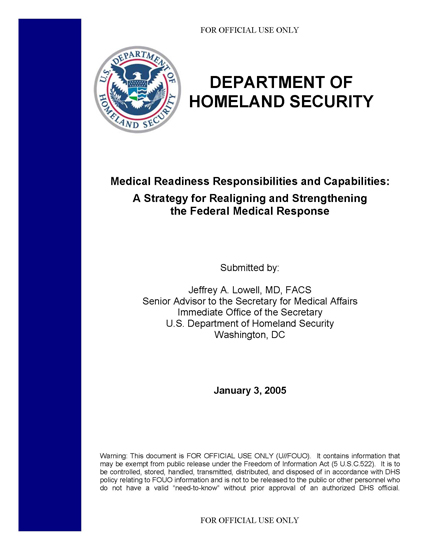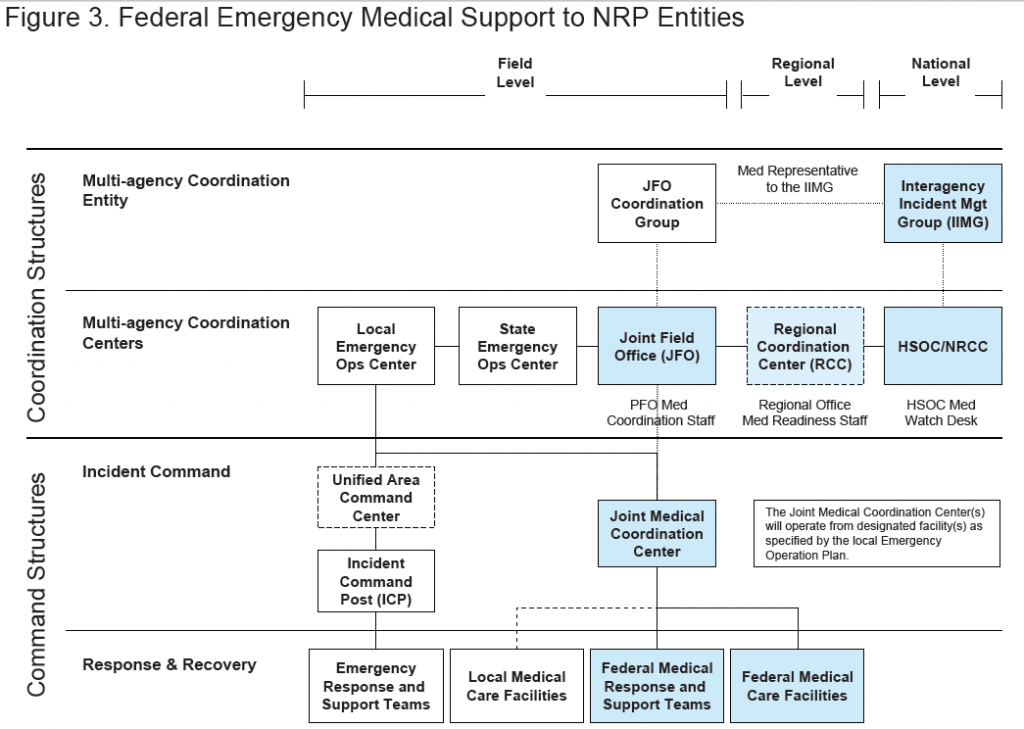Medical Readiness Responsibilities and Capabilities: A Strategy for Realigning and Strengthening the Federal Medical Response
- Jeffrey A. Lowell, MD, FACS, Senior Advisor to the Secretary for Medical Affairs, Immediate Office of the Secretary, U.S. Department of Homeland Security
- 103 pages
- For Official Use Only
- January 3, 2005
The Department of Homeland Security (DHS) has the responsibility to prevent, protect, respond to, and recover from major terrorist attacks or natural disasters, but currently lacks a clearly-defined and unified medical capability to support this mission. Additionally, it lacks the capability to properly support DHS personnel operating in field units and hazardous conditions by providing little or no medical support. Therefore, it is imperative that an Office of Medical Readiness becomes established within DHS, so these medical readiness responsibilities are addressed in a coordinated, effective, and efficient manner. A review of existing DHS medical readiness responsibilities and capabilities indicates a realignment of assets, personnel, and fiscal resources, is required.
Prior to the establishment of DHS, the Department of Health and Human Services (HHS) was responsible for national medical and public health programs. HHS responsibilities included preventive medicine, health promotion, and disaster medical response. With the passage of the Homeland Security Act 2002 and the establishment of DHS, the DHS Secretary was tasked to prevent, protect, respond to, and recover from incidents of national significance which includes a medical response. The Homeland Security Act also mandated the transfer of the HHS Office of Emergency Preparedness, the National Disaster Medical System (NDMS), Metropolitan Medical Response System (MMRS), the Strategic National Stockpile (SNS), as well as the functions of the HHS Secretary and Assistant Secretary for Public Health Emergency Preparedness to DHS. Homeland Security Presidential Directives (HSPDs) 5, 8, 9, and 10 specified additional DHS medical readiness requirements. However, portions of HSPD-10 and Emergency Support Function # 8 (ESF-8), Health and Medical Services of the National Response Plan (NRP) are currently in conflict with the requirements of the Homeland Security Act 2002.
In September 2004, Secretary Tom Ridge directed a review of the medical response requirements and capabilities within DHS. This report summarizes the findings of that review and provides a strategy for strengthening and realigning medical readiness assets within DHS and improving coordination and collaboration with other Federal partners. To ensure the Secretary of DHS has the ability to meet the demanding medical response requirements, the following actions are recommended:
• Appoint a DHS Assistant Secretary for Medical Readiness.
• Establish a DHS Office of Medical Readiness and provide the requisite staff, resources, and clearly-defined authorities and responsibilities.
• Realign key DHS medical intelligence, preparedness and response assets under this new office.
• Revise HSPD-10 and ESF-8 to bring them into compliance with the Homeland Security Act of 2002.
• Transform NDMS to provide the initial Federal medical response and sustain medical operations until transition to the recovery phase.
• Create an NDMS Advisory Board, chaired by the Assistant Secretary for Medical Readiness and consisting of senior representatives from each of the NDMS partner organizations, to provide strategic guidance to the Assistant Secretary’s staff to facilitate NDMS operations.
• Establish a national EMS coordination program in cooperation with relevant professional organizations.
• Establish and provide oversight for the DHS occupational health and safety program to protect DHS employees while on deployments and in the workplace.
• Provide force health protection for DHS field operating units/divisions (tactical deployments -e.g., Border and Transportation Security, Immigration and Customs Enforcement).
…
…
Surge Capacity
5. Finding: A national healthcare system-wide strategy for providing surge capacity does not exist. Thus, the ability to provide care to large numbers of casualties following a major incident remains one of the greatest challenges and vulnerabilities. Aggressive planning at local levels may have identified appropriate overflow facilities, but few communities have successfully met requirements for managing several hundred or thousands of patients. Numerous Federal programs (e.g., NDMS, Commissioned Corps Readiness Force, and the Medical Reserve Corps program) exist to enhance surge capacity, but they are fragmented and not incorporated into the national response effort.
Recommendation: Develop a surge capability to address not only facilities but healthcare personnel, equipment, supplies, and transportation assets to care for, track, house, feed, and if necessary the movement of injured personnel to locations where definitive care is available. Such a capability must: (1) be available within 12-24 hours to save the seriously injured, (2) not decimate the communities of the medical expertise required for normal operations, and
(3) must be sustainable for as long as required. Develop mechanisms to address personnel tracking, provider credentialing and privileging, interoperable data and communications, electronic patient tracking, and training and exercises.
…
HSPD-9: Food and Agriculture Terrorism
This directive establishes a national policy to defend the agriculture and food system against terrorist attacks, major disasters, and other emergencies.
The U.S. agriculture and food systems are vulnerable to disease, pest, or poisonous agents that occur naturally, are unintentionally introduced, or are intentionally delivered by acts of terrorism. The U.S. agriculture and food system is an extensive, open, interconnected, diverse, and complex structure providing potential targets for terrorist attacks. The best protection possible should be provided against a successful attack on the agriculture and food system which could have catastrophic health and economic effects.
As established in HSPD-7, the Secretary of Homeland Security is responsible for coordinating the overall national effort to enhance the protection of the critical infrastructure and key resources of the United States. The Secretary of Homeland Security shall serve as the PFO to lead, integrate, and coordinate implementation of efforts among Federal departments and agencies, State, and local governments, and the private sector to protect critical infrastructure and key resources. This directive shall be implemented in a manner consistent with HSPD-7.
The Attorney General, the Secretary of Homeland Security, and the Director of Central Intelligence, in coordination with the Secretaries of Agriculture, Health and Human Services, and the Administrator of the Environmental Protection Agency shall develop and enhance intelligence operations and analysis capabilities focusing on the agriculture, food, and water sectors. These intelligence capabilities will include collection and analysis of information concerning threats, delivery systems, and methods that could be directed against these sectors.
The Secretary of Homeland Security shall coordinate with the Secretaries of Agriculture, Health and Human Services, and the Administrator of the Environmental Protection Agency, and the heads of other appropriate Federal departments and agencies to create a new biological threat awareness capacity that will enhance detection and characterization of an attack. This new capacity will build upon the improved and upgraded surveillance systems described in paragraph 8 and integrate and analyze domestic and international surveillance and monitoring data collected from human health, animal health, plant health, food, and water quality systems.
…
HSPD-10: Biodefense
The essential pillars of the national biodefense program are: Threat Awareness, Prevention and Protection, Surveillance and Detection, and Response and Recovery.
Successful implementation of the program requires optimizing critical cross-cutting functions such as: information management and communications; research development and acquisition; creation and maintenance of needed biodefense infrastructure, including the human capital to support it; public preparedness; and strengthened bilateral, multilateral, and international cooperation.
National biodefense preparedness and response requires the involvement of a wide range of Federal departments and agencies. The Secretary of Homeland Security is the PFO for domestic incident management and is responsible for coordinating domestic Federal operations to prepare for, respond to, and recover from biological weapons attacks. The Secretary of Homeland Security coordinates, as appropriate, with the heads of other Federal departments and agencies to effectively accomplish this mission.
Assessments
One critical element of the biodefense policy is the development of periodic assessments of the evolving biological weapons threat. First, the United States requires a continuous, formal process for conducting routine capabilities assessments to guide prioritization of ongoing investments in biodefense-related research, development, planning, and preparedness. These assessments will be tailored to meet the requirements in each of these areas. Second, the United States requires a periodic senior-level policy net assessment that evaluates progress in implementing this policy, identifies continuing gaps or vulnerabilities in the biodefense posture, and makes recommendations for rebalancing and refining investments among the pillars of the overall biodefense policy. The Department of Homeland Security, in coordination with other appropriate Federal departments and agencies, will be responsible for conducting these assessments.
Critical Infrastructure Protection
Protecting the critical infrastructure from the effects of biological weapons attacks is a priority. A biological weapons attack could deny access to essential facilities and response capabilities. Therefore, efforts are underway to improve the survivability and ensure the continuity and restoration of operations of critical infrastructure sectors following biological weapons attacks. Assessing the vulnerability of this infrastructure, particularly the medical, public health, food, water, energy, agricultural, and transportation sectors, is the focus of current efforts. The Department of Homeland Security, in coordination with other appropriate Federal departments and agencies, leads these efforts which include developing and deploying biodetection technologies and decontamination methodologies.


